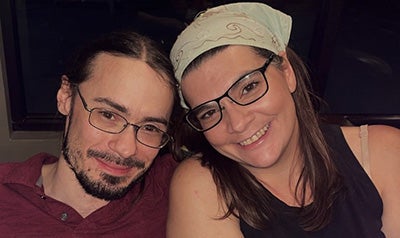Scoliosis
Growing up in Cullman, Alabama, Brooke Uptagrafft Hershberger was twice a patient at Children’s of Alabama—once after a car accident, then later for scoliosis. Years later, after working as a medical professional herself, she still has fond memories of the way Children’s staff helped her.
Her first encounter with Children’s was in 1994, when she was 5 years old. “My family was involved in a car accident where everyone was injured, and my sister and I broke our backs with identical injuries,” she said.
At that time, she and her sister were treated at Children’s, where she remembers kindness from those who cared for their well-being. Both siblings wore full-body casts to help them heal properly. They spent a month in the hospital and had follow-up visits until they were healed.
It wasn’t until 10 years later that Brooke found herself seeking medical attention at Children's again—this time for scoliosis, an abnormal curvature of the spine.
When she was 15 years old, a PE teacher discovered the condition during an annual scoliosis exam at her school. She was instructed to see an orthopedic specialist, so she returned to Children’s, where she was diagnosed with idiopathic scoliosis. The condition is usually found in young people going through puberty. While it’s not clear what causes it, it tends to run in families.
Over the next year, doctors prescribed two different back braces to try to correct the condition, but the curvature in her spine continued to get worse. As a result, they recommended surgery to prevent further worsening. Brooke would have a posterior spinal fusion with instrumentation, an operation in which an orthopedic surgeon straightens the spine as much as possible and holds it in place with rods and screws. The surgeon then puts in a bone graft to fuse some of the vertebrae together. That way, the curve can't get any worse. After about a year, the bones should be fully fused. The metal rods are no longer needed, but they stay in the back because they aren't doing any harm, and taking them out requires another operation.
Brooke remained in the hospital for about two weeks following her surgery and finished her recovery at home over the following months. She also went through physical therapy.
“I never had a bad experience at Children’s,” she said. “Every experience I had there was wonderful. The hospital is so whimsical and interesting; the artwork was intriguing as a kid…and the people there. It's been a sense of inspiration for me.”
Today, Brooke says orthopedic specialists have commented on how well her childhood surgery was done. Though it was a success at that time, she says she still experiences pain. She may eventually have to have surgery again. “My upper neck area and my lower back area still have scoliosis,” she explained.
Despite the physical challenges she still faces, Brooke tries to stay active and enjoys activities such as kayaking. She recently married and now lives in Cullman. “I try to keep the bones moving and the muscles moving,” she said. “When I'm doing physical therapy and stuff, my pain is reduced tremendously. So, it's all about maintenance.”
After earning an associate degree in applied science and certification as a lab tech assistant, Brooke went on to work as a phlebotomist in the emergency department at a hospital in Rome, Georgia.
“It was kind of a full circle moment for me,” she said. “I try to share the same kindness I received as a child with the patients. Paying it forward, in a sense.”





